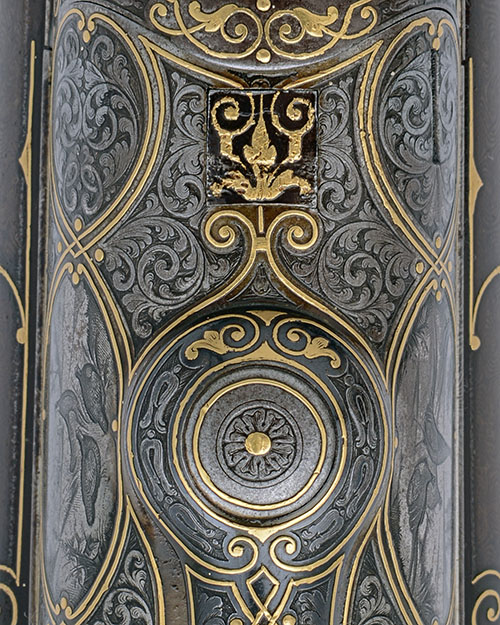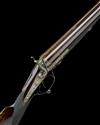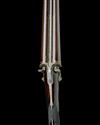Product Details
BEARING THE ROYAL CREST OF KING LEOPOLD II OF BELGIUM
AD. JANSEN
A FINE, GOLD-ENCRUSTED 12-BORE ROTARY-UNDERLEVER HAMMERGUN, serial no. 13531,
30in. nitro reproved (in 2016) fine damascus barrels by E. Bernard, the breech ends finely decorated with gold geometric designs, the rib gold-inlaid 'AD. JANSEN ARQ.-DU ROI A BRUXELLES', 2 1/2in. chambers, bored approx. true cyl. in both, rotary underlever, slender carved serpentine fences, non-rebounding back-action locks with carved high-spurred hammers of hare's-ear form, the action, lockplates and furniture carved with bold stylised acanthus designs on a finely matted background, gold geometric line and floral design highlighting and framing fine vignettes of game scenes involving roe buck, pheasant, stag and partridge, the lockplates signed 'AD JANSEN ARQ DU ROI' and 'AD JANSEN A BRUXELLES', retaining some original colour-hardening and finish, 14 3/8in. well-figured stock with engraved and gold-inlaid steel buttplate, the stock inset with a blued oval escutcheon relief engraved and gold-inlaid with the Royal Garter, reverse L monogram and surmounted by a Royal crown, weight 7lb. 8oz.
Provenance: King Leopold II (9th April 1835 - 17th December 1909) was the second King of the Belgians, and the longest reigning of any Belgian monarch, being on the throne for 44 years from the 17th December 1865 until his death on the 17th December 1909. He is probably mostly remembered for the founding and exploitation of the Congo Free State.
Leopold was the founder and sole owner of the Congo Free State, a private project undertaken on his own behalf. He used the famous explorer Henry Morton Stanley to help him lay claim to the Congo, an area now known as the Democratic Republic of the Congo. At the Berlin Conference of 1884-1885, the colonial nations of Europe authorized his claim by committing the Congo Free State to improving the lives of the native inhabitants. From the beginning, however, Leopold essentially ignored these conditions. He ran the Congo using a mercenary force for his personal enrichment.
Leopold extracted a fortune from the Congo, initially by the collection of ivory, and after a rise in the price of rubber in the 1890s, by forced labour from the natives to harvest and process rubber. Under his regime millions of Congolese people died; modern estimates range from 1 to 15 million, with a consensus growing around 10 million. Human rights abuses under his regime contributed significantly to these deaths.
King Leopold's Congo Free State was famously recounted in Joseph Conrad's novel "Heart of Darkness", which helped to stimulate organised international criticism of Leopold's rule, which led a major international scandal in the early 20th century, and Leopold was ultimately forced by the Belgian government to relinquish control of the colony to the civil administration in 1908.
He used great sums of the money from this exploitation commissioning a great number of public works, buildings and urban projects including the Hippodrome Wellington, the Royal Galleries in Ostend, the Royal Museum for Central Africa in Tervuren, and the Duden Park in Brussels. In addition to his public works he acquired and built numerous private properties for himself. Thinking to the future after his death, Leopold did not want the collection of estates, lands and heritage buildings he had privately amassed to be scattered amongst his daughters, each of whom was married to a foreign prince. In 1900, he created the Royal Trust, by means of which he donated most of his property to the Belgian nation. This preserved them to beautify Belgium in perpetuity, while still allowing future generations of the Belgian Royal family the privilege of their use.
Leopold had many mistresses. In 1899 at age 65, he took Caroline Lacroix, a 16-year-old French prostitute as a mistress, and they remained together for the next decade until his death. Leopold lavished upon her large sums of money, estates, gifts, and a noble title, Baroness Vaughan. Because of these gifts and the illegitimacy of their relationship, Caroline was deeply unpopular among the Belgian people and internationally.
Leopold died on the 17th December 1909, by the end of his reign he was so unpopular that his funeral procession was booed. After his death there occurred a "great forgetting", and many Belgians in the 20th and 21st centuries remember Leopold II as the "Builder King" for his extensive public works projects, and many remain unaware of his role in the atrocities in the Congo. In the 1990s, the colonial Royal Museum for Central Africa made no mention of the atrocities committed in the Congo Free State, despite the museum's large collection of colonial objects.
Please click HERE to view Terms & Conditions.
Estimate £3,000-5,000
S2








